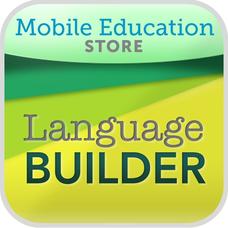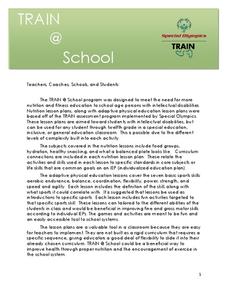Curated OER
Fighting for Whose Freedom? Black Soldiers in the American Revolution
Students analyze primary sources about black soldiers in the American Revolution. They apply independent conclusions to create a piece of historical fiction. Students come to understand that as soldiers, scouts, or spies,...
Curated OER
Self-Management Unit
Students explain how self-concept is built and preserved and how it relates to the perception of individual strengths and weaknesses. They explore self-concept, character & integrity, labeling, values, goals and decision making.
Curated OER
Personal Culture
Students investigate personal culture. They go throughout the community taking pictures and saving the images to create a personal photo book. The information can be displayed in either a digital or hard copy. The goal of the lesson is...
Curated OER
Do You Know What You Just Read?
Students answer reading comprehension questions using the "story grammar" technique. They listen to a story and then answer questions using the technique: main character, setting, main events, and resolution. Students complete an...
Curated OER
Gathering, Recording, and Presenting Data
Sixth graders use the local newspaper to find and discuss examples of uses of statistics and the ways in which the information is presented. They create and represent their own set of data showing how students get to school each day.
Curated OER
Why Is Evolution Controversial?
Young scholars examine the legal side of the teaching of evolution. They study the Scopes Trial and reflect on what it means for a teacher to be denied the right to teach a key scientific concept. In addition, they design their own...
Curated OER
Remembering What We Read
Students discover strategies to help them better understand the stories they read. As a familiar story is read to the class, individuals practice answering basic questions about the main characters, settings, problems, etc. while...
Curated OER
Mystery Cemetary: Teachers
Young scholars examine and analyze the skeletons of various bodies that could represent a cemetary. In groups, they identify a set of common characteristics in which the skeletons are grouped. To end the lesson plan, they answer...
Florida Center for Reading Research
Comprehension: Text Analysis, Fact or Opinion Football
Touchdown! Try out this game to help your learners differentiate between fact and opinion. In pairs, pupils switch off reading cards to one another. Learners determine if the sentences on the cards are facts or opinions and continue...
Missouri Department of Elementary
What are Comfortable (Good) and Uncomfortable (Bad) Feelings?
Two puppets open a discussion about comfrotable and uncomfortable touches. Scholars add to the discussion information they remember from a previous instructional activity, then delve deep into three problem-solving safety rules, and...
New York State Education Department
TASC Transition Curriculum: Workshop 3
Teachers turning into high schoolers? It's not Freaky Friday! It's a thoughtful workshop that teaches participants how to plan professional development for staff. Third in a 15-part series, the workshop provides a platform for the other...
Sea World
Penguins
Everyone loves penguins! Learn about the flightless birds of the Antarctic with a series of lessons and activities. From the differences between the 17 species of penguins to the best way to remove oil from a penguin's features,...
Missouri Department of Elementary
The Successful Student: Picturing the Successful Student
Class groups brainstorm the characteristics that make up a successful student before taking part in a whole class discussion. Assigned group roles promote member participation.
Choose My Plate
My Daily Food Plan (18+ years old)
Manage your calorie intake with a daily food plan journal. After reviewing a reference sheet with suggested amounts of each food group based on a total calorie pattern, learners can jot down what foods they have eaten during the day as...
University of Minnesota
Beautiful Brain: Brain Inspiration
"Neuroscientists consider Cajal as important to their discipline as Einstein is to physics." The first of four lessons has scholars view Santiago Ramon y Cajal's drawings of neurons. They reflect and respond to the art through writing...
New York State Education Department
TASC Transition Curriculum: Workshop 7
Designed specifically for math instructors, the seventh workshop of a 15-part series allows time to explore Webb's DOK, ponder open-ended questions, and create lessons to apply what is learned. Teachers craft high-quality math problems...
Mobile Education Store
LanguageBuilder for iPad
Help your child hone his/her verbal communication skills and basic understanding of sentence structure with an app that promotes descriptive verbal interactions. The child is presented with an image, prompted to make a sentence, and then...
Healthy Native Youth
Chapter 5: Learning About HIV/AIDS/STI's and Hepatitis Transmission
Middle schoolers delve deep into facts about HIV, AIDS, Hepatitis, and other STI's by way of discussion and a hands-on activity. Scholars ask and discuss questions anonymously using a Question Box. Two experiments showcase the...
Space Awareness
Investigating the Atmosphere - Air Takes Up Space
How do you know there is air? Can you see it, smell it, feel it? To begin the investigation, learners watch a video and discuss what they know about air and the atmosphere. Then, they participate in five different hands-on, inquiry-based...
Transforming Education
Self-Efficacy Toolkit
A PowerPoint presentation prepares instructors for teaching learners about self-efficacy, a key competency of social-emotional learning. The 29-page presentation is designed to give administrators and teachers a deeper understanding of...
Education.com
Winter Break Survival Kit
Help parents and children survive the long winter break with this collection of fun activities. Offering suggestions for volunteering during the holidays and making family New Year's resolutions, as well as a variety...
Education Fund
Fear the Scarce Resources
In a life or death situation, what resources would you choose to survive—and why? A zombie attack simulation teaches learners the concepts of scarcity and resources in regards to economics. The hands-on activity requires individuals to...
Special Olympics
Train at School
Keep your mind and body fit with a fun activity about the five food groups. After going over the functions of fruit, vegetables, grains, meats and beans, and dairy, as well as oils and fats, learners participate in a bean bag toss...
Mathematics Vision Project
Module 3: Polynomial Functions
An informative module highlights eight polynomial concepts. Learners work with polynomial functions, expressions, and equations through graphing, simplifying, and solving.

























